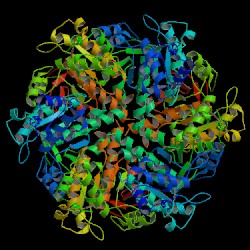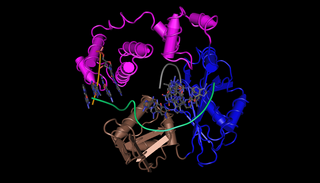DNA repair protein RAD51 homolog 2 is a protein that in humans is encoded by the RAD51L1 gene. [5] [6] [7]
DNA repair protein RAD51 homolog 2 is a protein that in humans is encoded by the RAD51L1 gene. [5] [6] [7]
The protein encoded by this gene is a member of the RAD51 protein family. RAD51 family members are evolutionarily conserved proteins essential for DNA repair by homologous recombination. This protein has been shown to form a stable heterodimer with the family member RAD51C, which further interacts with the other family members, such as RAD51, XRCC2, and XRCC3. Overexpression of this gene was found to cause cell cycle G1 delay and cell apoptosis, which suggested a role of this protein in sensing DNA damage. At least three alternatively spliced transcript variants encoding distinct isoforms have been observed. [7]
RAD51L1 is employed in the repair of DNA double-strand breaks. [8] Different polymorphisms of the RAD51L1 gene modulate sensitivity to gamma rays and also glioma risk. [8]
RAD51L1 has been shown to interact with RAD51C. [9] [10] [11]

BRCA2 and BRCA2 are human genes and their protein products, respectively. The official symbol and the official name are maintained by the HUGO Gene Nomenclature Committee. One alternative symbol, FANCD1, recognizes its association with the FANC protein complex. Orthologs, styled Brca2 and Brca2, are common in other vertebrate species. BRCA2 is a human tumor suppressor gene, found in all humans; its protein, also called by the synonym breast cancer type 2 susceptibility protein, is responsible for repairing DNA.

DNA repair protein RAD51 homolog 1 is a protein encoded by the gene RAD51. The enzyme encoded by this gene is a member of the RAD51 protein family which assists in repair of DNA double strand breaks. RAD51 family members are homologous to the bacterial RecA, Archaeal RadA ,and yeast Rad51. The protein is highly conserved in most eukaryotes, from yeast to humans.

Ku80 is a protein that, in humans, is encoded by the XRCC5 gene. Together, Ku70 and Ku80 make up the Ku heterodimer, which binds to DNA double-strand break ends and is required for the non-homologous end joining (NHEJ) pathway of DNA repair. It is also required for V(D)J recombination, which utilizes the NHEJ pathway to promote antigen diversity in the mammalian immune system.

DNA repair protein XRCC3 is a protein that in humans is encoded by the XRCC3 gene.

Bloom syndrome protein is a protein that in humans is encoded by the BLM gene and is not expressed in Bloom syndrome.

DNA polymerase lambda, also known as Pol λ, is an enzyme found in all eukaryotes. In humans, it is encoded by the POLL gene.

Fanconi anemia group G protein is a protein that in humans is encoded by the FANCG gene.

RAD52 homolog , also known as RAD52, is a protein which in humans is encoded by the RAD52 gene.

RAD51 homolog C , also known as RAD51C, is a protein which in humans is encoded by the RAD51C gene.

DNA repair protein RAD51 homolog 4 is a protein that in humans is encoded by the RAD51L3 gene.

DNA repair protein XRCC2 is a protein that in humans is encoded by the XRCC2 gene.

Meiotic recombination protein DMC1/LIM15 homolog is a protein that in humans is encoded by the DMC1 gene.

Protein FAM107A is a protein that in humans is encoded by the FAM107A gene.

Crossover junction endonuclease MUS81 is an enzyme that in humans is encoded by the MUS81 gene.

E3 ubiquitin-protein ligase FANCL is an enzyme that in humans is encoded by the FANCL gene.

ATP-dependent DNA helicase Q1 is an enzyme that in humans is encoded by the RECQL gene.

Adaptin ear-binding coat-associated protein 2 is a protein that in humans is encoded by the NECAP2 gene.

DNA repair and recombination protein RAD54B is a protein that in humans is encoded by the RAD54B gene.

JNK1-associated membrane protein is a protein that in humans is encoded by the JKAMP gene.

Protein ZGRF1 is a protein encoded in the human by the ZGRF1 gene also known as C4orf21, that has a weight of 236.6 kDa. The ZGRF1 gene product localizes to the cell nucleus and promotes DNA repair by stimulating homologous recombination. This gene shows relatively low expression in most human tissues, with increased expression in situations of chemical dependence. ZGRF1 is orthologous to nearly all eukaryotes. Functional domains of this protein link it to a series of helicases, most notably the AAA_12 and AAA_11 domains.